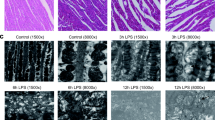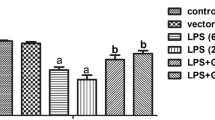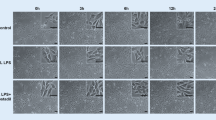Abstract
Cardiac dysfunction in severe sepsis is associated with increased mortality. However, the molecular mechanisms underlying septic heart dysfunction remain unclear. Expression of peroxisome proliferator-activated receptor-γ coactivator 1α (Pgc-1α), concentrations of inflammatory factors, and activation of the nuclear factor kappa-B (NF-κB) signaling pathway were examined in H9c2 cells after a 24-h lipopolysaccharide (LPS) stimulation period using qPCR, enzyme-linked immunosorbent assays (ELISAs), and western blots (WBs), respectively. Pgc-1α was overexpressed and suppressed in cells using a lentivirus vector and siRNA, respectively. The effects of Pgc-1α dysfunction on the release of inflammatory factors and apoptosis were analyzed. Pgc-1α expression was increased after LPS induction for 0.5 h and returned to the pre-induction level at 2 h. Levels of IL-1β, IL-6, and TNF-α increase after LPS induction for 0.5 h and accumulated in the culture supernatants over time. The WBs revealed the highest Pgc-1α and phospho (p)-p65 protein levels after LPS induction for 0.5 h, followed by a decrease; moreover, the cleaved-caspase-3 level increased after LPS induction for 0.5 h and increased gradually thereafter. A functional analysis of Pgc-1α revealed that overexpression of this protein enhanced LPS-induced inflammatory factors and p-p65 levels and inhibited apoptosis during the early stage after LPS induction (0.5 and 4 h). In contrast, the inhibition of Pgc-1α expression inhibited the LPS expression–associated increases in inflammatory factors and p-p65 and promoted apoptosis. Pgc-1α promoted LPS-induced p65 phosphorylation and inflammatory factor release while inhibiting apoptosis.





Similar content being viewed by others
Data Availability
The datasets generated during and/or analyzed during the current study are available from the corresponding author on reasonable request.
References
Flynn, A., B. Chokkalingam Mani, and P.J. Mather. 2010. Sepsis-induced cardiomyopathy: a review of pathophysiologic mechanisms. Heart Failure Reviews 15 (6): 605–611.
Pulido, J.N., B. Afessa, M. Masaki, T. Yuasa, S. Gillespie, V. Herasevich, D.R. Brown, and J.K. Oh. 2012. Clinical spectrum, frequency, and significance of myocardial dysfunction in severe sepsis and septic shock. Mayo Clinic Proceedings 87 (7): 620–628.
Li, L., B.C. Hu, C.Q. Chen, S.J. Gong, Y.H. Yu, H.W. Dai, and J. Yan. 2013. Role of mitochondrial damage during cardiac apoptosis in septic rats. Chinese Medical Journal 126 (10): 1860–1866.
Blanco, J., A. Muriel-Bombin, V. Sagredo, F. Taboada, F. Gandia, L. Tamayo, J. Collado, A. Garcia-Labattut, D. Carriedo, M. Valledor, M. De Frutos, M.J. Lopez, A. Caballero, J. Guerra, B. Alvarez, A. Mayo, and J. Villar. 2008. Incidence, organ dysfunction and mortality in severe sepsis: a Spanish multicentre study. Critical Care 12 (6): R158.
Granton, J.T., C.M. Goddard, M.F. Allard, S. van Eeden, and K.R. Walley. 1997. Leukocytes and decreased left-ventricular contractility during endotoxemia in rabbits. American Journal of Respiratory and Critical Care Medicine 155 (6): 1977–1983.
Herbertson, M.J., H.A. Werner, and K.R. Walley. 1996. Nitric oxide synthase inhibition partially prevents decreased LV contractility during endotoxemia. The American Journal of Physiology 270 (6 Pt 2): H1979–H1984.
Wei, W.Y., Z.G. Ma, N. Zhang, S.C. Xu, Y.P. Yuan, X.F. Zeng, and Q.Z. Tang. 2018. Overexpression of CTRP3 protects against sepsis-induced myocardial dysfunction in mice. Molecular and Cellular Endocrinology 476: 27–36.
Neviere, R., H. Fauvel, C. Chopin, P. Formstecher, and P. Marchetti. 2001. Caspase inhibition prevents cardiac dysfunction and heart apoptosis in a rat model of sepsis. American Journal of Respiratory and Critical Care Medicine 163 (1): 218–225.
Wang, Y., X. Yu, F. Wang, Y. Wang, Y. Wang, H. Li, X. Lv, D. Lu, and H. Wang. 2013. Yohimbine promotes cardiac NE release and prevents LPS-induced cardiac dysfunction via blockade of presynaptic alpha2A-adrenergic receptor. PLoS One 8 (5): e63622.
O'Sullivan, A.W., J.H. Wang, and H.P. Redmond. 2009. NF-kappaB and p38 MAPK inhibition improve survival in endotoxin shock and in a cecal ligation and puncture model of sepsis in combination with antibiotic therapy. The Journal of Surgical Research 152 (1): 46–53.
Fitzgerald, K.A., E.M. Palsson-McDermott, A.G. Bowie, C.A. Jefferies, A.S. Mansell, G. Brady, E. Brint, A. Dunne, P. Gray, M.T. Harte, D. McMurray, D.E. Smith, J.E. Sims, T.A. Bird, and L.A. O'Neill. 2001. Mal (MyD88-adapter-like) is required for Toll-like receptor-4 signal transduction. Nature 413 (6851): 78–83.
Tran, M., D. Tam, A. Bardia, M. Bhasin, G.C. Rowe, A. Kher, Z.K. Zsengeller, M.R. Akhavan-Sharif, E.V. Khankin, M. Saintgeniez, S. David, D. Burstein, S.A. Karumanchi, I.E. Stillman, Z. Arany, and S.M. Parikh. 2011. PGC-1alpha promotes recovery after acute kidney injury during systemic inflammation in mice. The Journal of Clinical Investigation 121 (10): 4003–4014.
Alvarez-Guardia, D., X. Palomer, T. Coll, M.M. Davidson, T.O. Chan, A.M. Feldman, J.C. Laguna, and M. Vázquez-Carrera. 2010. The p65 subunit of NF-kappaB binds to PGC-1alpha, linking inflammation and metabolic disturbances in cardiac cells. Cardiovascular Research 87 (3): 449–458.
DeForge, L.E., and D.G. Remick. 1991. Kinetics of TNF, IL-6, and IL-8 gene expression in LPS-stimulated human whole blood. Biochemical and Biophysical Research Communications 174 (1): 18–24.
Song, R., J. Kim, D. Yu, C. Park, and J. Park. 2012. Kinetics of IL-6 and TNF-alpha changes in a canine model of sepsis induced by endotoxin. Veterinary Immunology and Immunopathology 146 (2): 143–149.
Takano, H., T. Nagai, M. Asakawa, T. Toyozaki, T. Oka, I. Komuro, T. Saito, and Y. Masuda. 2000. Peroxisome proliferator-activated receptor activators inhibit lipopolysaccharide-induced tumor necrosis factor-alpha expression in neonatal rat cardiac myocytes. Circulation Research 87 (7): 596–602.
Planavila, A., R.M. Sanchez, M. Merlos, J.C. Laguna, and M. Vazquez-Carrera. 2005. Atorvastatin prevents peroxisome proliferator-activated receptor gamma coactivator-1 (PGC-1) downregulation in lipopolysaccharide-stimulated H9c2 cells. Biochimica et Biophysica Acta 1736 (2): 120–127.
Mootha, V.K., C.M. Lindgren, K.F. Eriksson, A. Subramanian, S. Sihag, J. Lehar, P. Puigserver, E. Carlsson, M. Ridderstrale, E. Laurila, N. Houstis, M.J. Daly, N. Patterson, J.P. Mesirov, T.R. Golub, P. Tamayo, B. Spiegelman, E.S. Lander, J.N. Hirschhorn, D. Altshuler, and L.C. Groop. 2003. PGC-1alpha-responsive genes involved in oxidative phosphorylation are coordinately downregulated in human diabetes. Nature Genetics 34 (3): 267–273.
Shao, D., Y. Liu, X. Liu, L. Zhu, Y. Cui, A. Cui, A. Qiao, X. Kong, Y. Liu, Q. Chen, N. Gupta, F. Fang, and Y. Chang. 2010. PGC-1 beta-regulated mitochondrial biogenesis and function in myotubes is mediated by NRF-1 and ERR alpha. Mitochondrion 10 (5): 516–527.
Eisele, P.S., S. Salatino, J. Sobek, M.O. Hottiger, and C. Handschin. 2013. The peroxisome proliferator-activated receptor γ coactivator 1α/β (PGC-1) coactivators repress the transcriptional activity of NF-κB in skeletal muscle cells. The Journal of Biological Chemistry 288 (4): 2246–2260.
Arany, Z., H. He, J. Lin, K. Hoyer, C. Handschin, O. Toka, F. Ahmad, T. Matsui, S. Chin, P.H. Wu, I.I. Rybkin, J.M. Shelton, M. Manieri, S. Cinti, F.J. Schoen, R. Bassel-Duby, A. Rosenzweig, J.S. Ingwall, and B.M. Spiegelman. 2005. Transcriptional coactivator PGC-1 alpha controls the energy state and contractile function of cardiac muscle. Cell Metabolism 1 (4): 259–271.
Fang, W.J., C.J. Wang, Y. He, Y.L. Zhou, X.D. Peng, and S.K. Liu. 2018. Resveratrol alleviates diabetic cardiomyopathy in rats by improving mitochondrial function through PGC-1alpha deacetylation. Acta Pharmacologica Sinica 39 (1): 59–73.
Cao, J., J.A. McClung, M. Waldman, S.P. Singh, J. Schragenheim, M. Arad, E. Hochhauser, and N. Abraham. 2016. PGC-1α is a critical activator of HO-1 that protects against cardiomyopathy in diabetic mice through recruitment of mitochondrial fusion proteins and function. Hypertension 68 (suppl_1): A024.
Kawamura, N., T. Kubota, S. Kawano, Y. Monden, A.M. Feldman, H. Tsutsui, A. Takeshita, and K. Sunagawa. 2005. Blockade of NF-kappaB improves cardiac function and survival without affecting inflammation in TNF-alpha-induced cardiomyopathy. Cardiovascular Research 66 (3): 520–529.
Liu, H., and S.S. Lee. 2008. Nuclear factor-kappaB inhibition improves myocardial contractility in rats with cirrhotic cardiomyopathy. Liver International 28 (5): 640–648.
Thomas, C.M., Q.C. Yong, R.M. Rosa, R. Seqqat, S. Gopal, D.E. Casarini, W.K. Jones, S. Gupta, K.M. Baker, and R. Kumar. 2014. Cardiac-specific suppression of NF-kappaB signaling prevents diabetic cardiomyopathy via inhibition of the renin-angiotensin system. American Journal of Physiology. Heart and Circulatory Physiology 307 (7): H1036–H1045.
Rajesh, M., P. Mukhopadhyay, S. Batkai, V. Patel, K. Saito, S. Matsumoto, Y. Kashiwaya, B. Horvath, B. Mukhopadhyay, L. Becker, G. Hasko, L. Liaudet, D.A. Wink, A. Veves, R. Mechoulam, and P. Pacher. 2010. Cannabidiol attenuates cardiac dysfunction, oxidative stress, fibrosis, and inflammatory and cell death signaling pathways in diabetic cardiomyopathy. Journal of the American College of Cardiology 56 (25): 2115–2125.
Hall, G., I.S. Singh, L. Hester, J.D. Hasday, and T.B. Rogers. 2005. Inhibitor-kappaB kinase-beta regulates LPS-induced TNF-alpha production in cardiac myocytes through modulation of NF-kappaB p65 subunit phosphorylation. American Journal of Physiology. Heart and Circulatory Physiology 289 (5): H2103–H2111.
Tien, Y.C., J.Y. Lin, C.H. Lai, C.H. Kuo, W.Y. Lin, C.H. Tsai, F.J. Tsai, Y.C. Cheng, W.H. Peng, and C.Y. Huang. 2010. Carthamus tinctorius L. prevents LPS-induced TNFalpha signaling activation and cell apoptosis through JNK1/2-NFkappaB pathway inhibition in H9c2 cardiomyoblast cells. Journal of Ethnopharmacology 130 (3): 505–513.
Kumar, S. 2007. Caspase function in programmed cell death. Cell Death and Differentiation 14 (1): 32–43.
Communal, C., M. Sumandea, P. de Tombe, J. Narula, R.J. Solaro, and R.J. Hajjar. 2002. Functional consequences of caspase activation in cardiac myocytes. Proceedings of the National Academy of Sciences of the United States of America 99 (9): 6252–6256.
Neviere, R., S.M. Hassoun, B. Decoster, Y. Bouazza, D. Montaigne, X. Marechal, C. Marciniak, P. Marchetti, and S. Lancel. 2010. Caspase-dependent protein phosphatase 2A activation contributes to endotoxin-induced cardiomyocyte contractile dysfunction. Critical Care Medicine 38 (10): 2031–2036.
Kumar, A., A. Kumar, P. Michael, D. Brabant, A.M. Parissenti, C.V. Ramana, X. Xu, and J.E. Parrillo. 2005. Human serum from patients with septic shock activates transcription factors STAT1, IRF1, and NF-kappaB and induces apoptosis in human cardiac myocytes. The Journal of Biological Chemistry 280 (52): 42619–42626.
Acknowledgements
Not applicable.
Funding
This work was supported by the Basic Research Project of Shenzhen Science and technology from Shenzhen Science and Technology Innovation Commission [JCYJ20160425104402559].
Author information
Authors and Affiliations
Contributions
DL conceived and designed the study, and critically revised the manuscript. QH performed the experiments, analyzed the data, and drafted the manuscript. CC, YH, ZH, JZ, and XZ participated in study design, study implementation, and manuscript revision. All authors read and approved the final manuscript.
Corresponding author
Ethics declarations
Ethics Approval and Consent to Participate
Not applicable.
Consent for Publication
Not applicable.
Competing Interests
The authors declare that they have no competing interests.
Additional information
Publisher’s Note
Springer Nature remains neutral with regard to jurisdictional claims in published maps and institutional affiliations.
Supplementary Information
Supplementary Figure 1.
The map of LV003 vector. (PNG 618 kb)
Rights and permissions
About this article
Cite this article
Huang, Q., Liu, DH., Chen, CF. et al. Pgc-1α Promotes Phosphorylation, Inflammation, and Apoptosis in H9c2 Cells During the Early Stage of Lipopolysaccharide Induction. Inflammation 44, 1771–1781 (2021). https://doi.org/10.1007/s10753-021-01453-8
Received:
Revised:
Accepted:
Published:
Issue Date:
DOI: https://doi.org/10.1007/s10753-021-01453-8




